



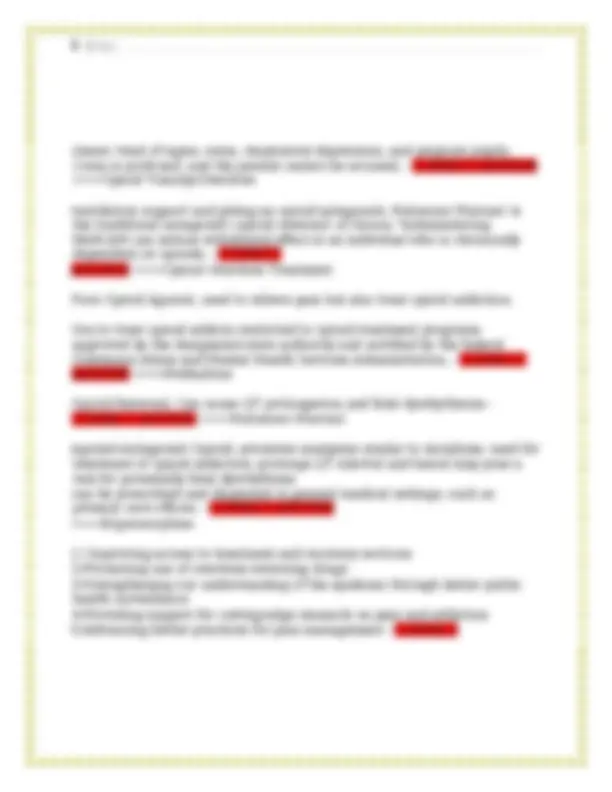
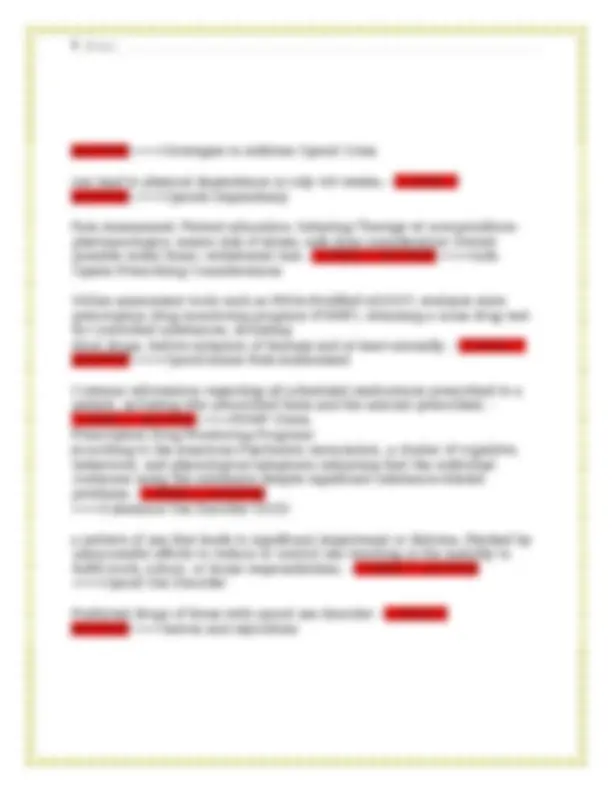
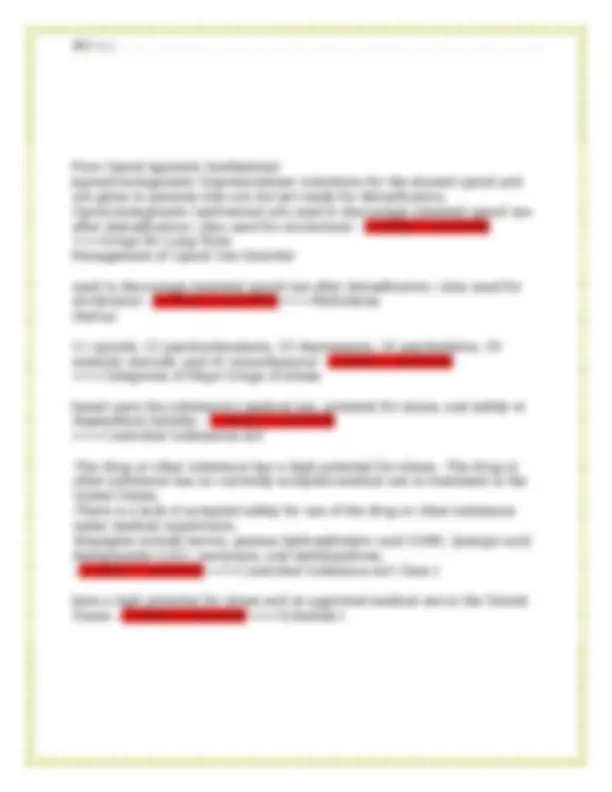
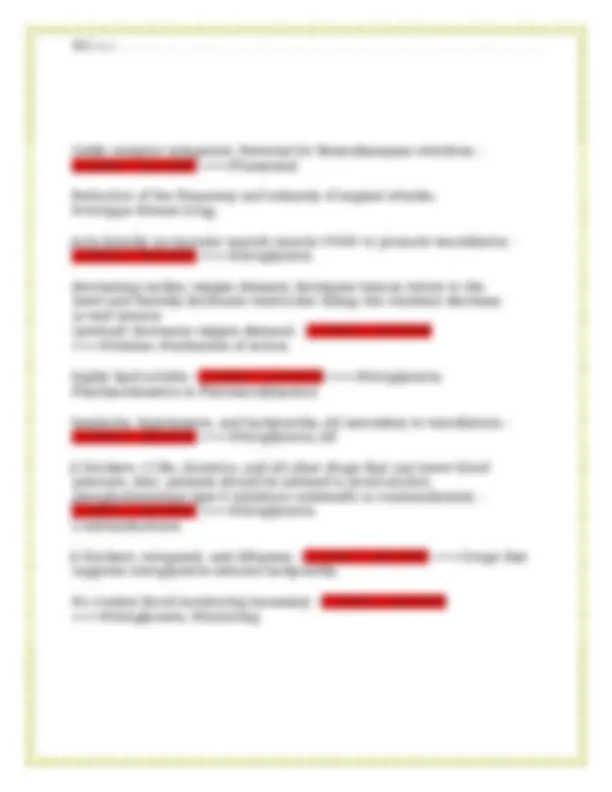
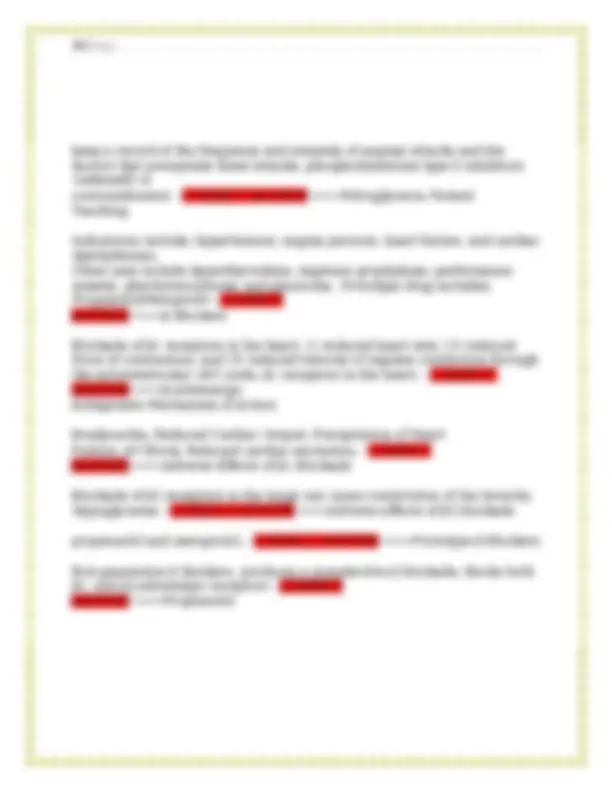
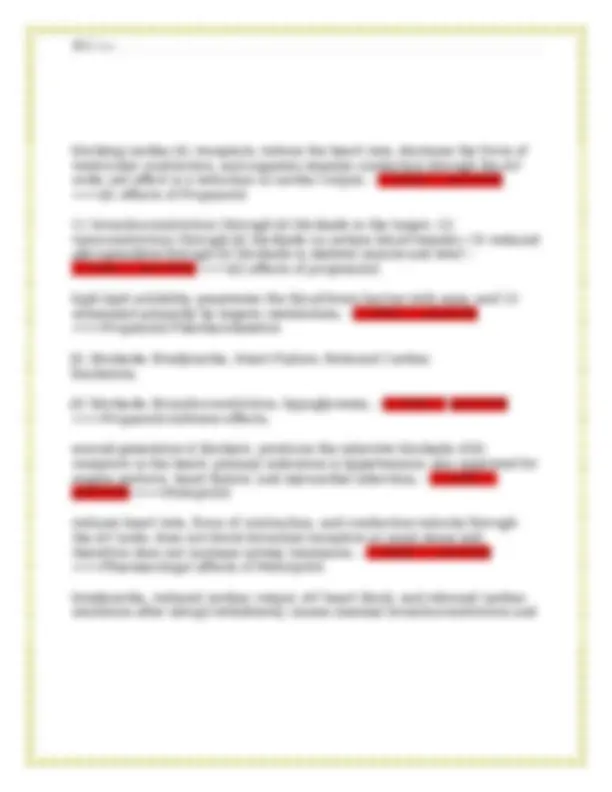
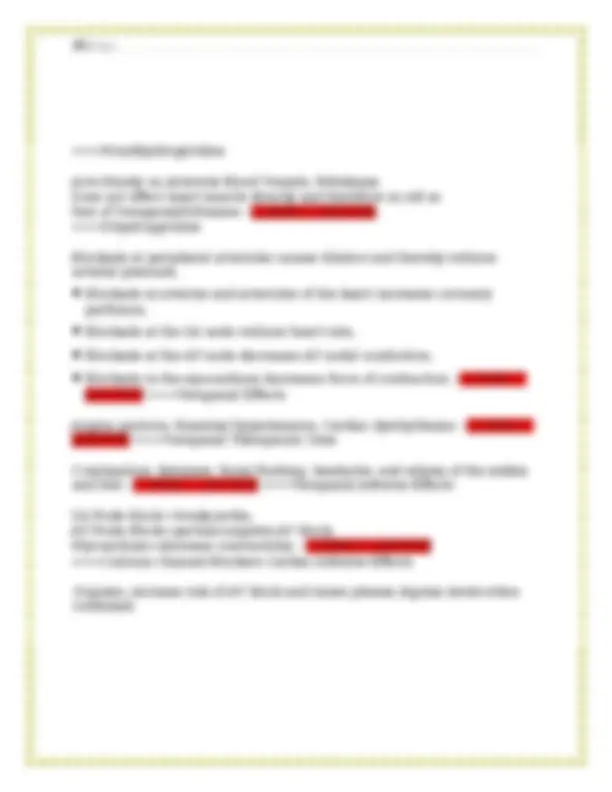
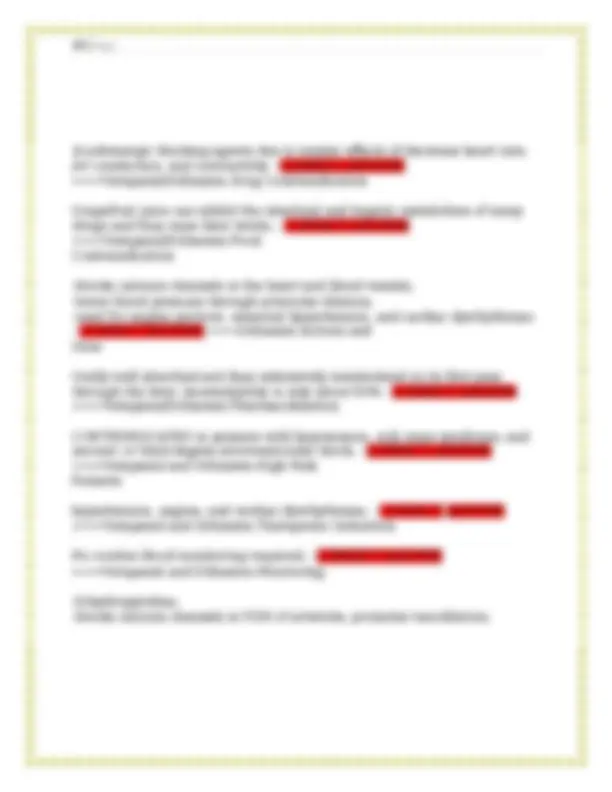
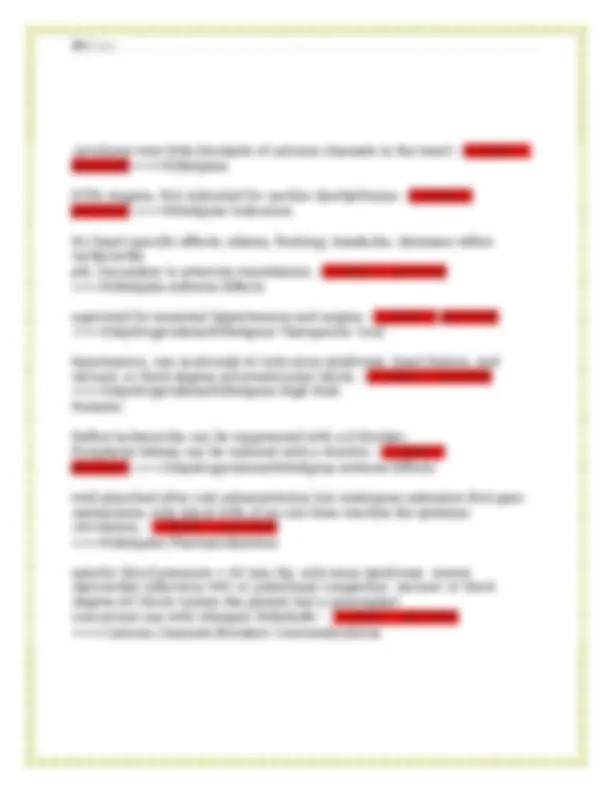
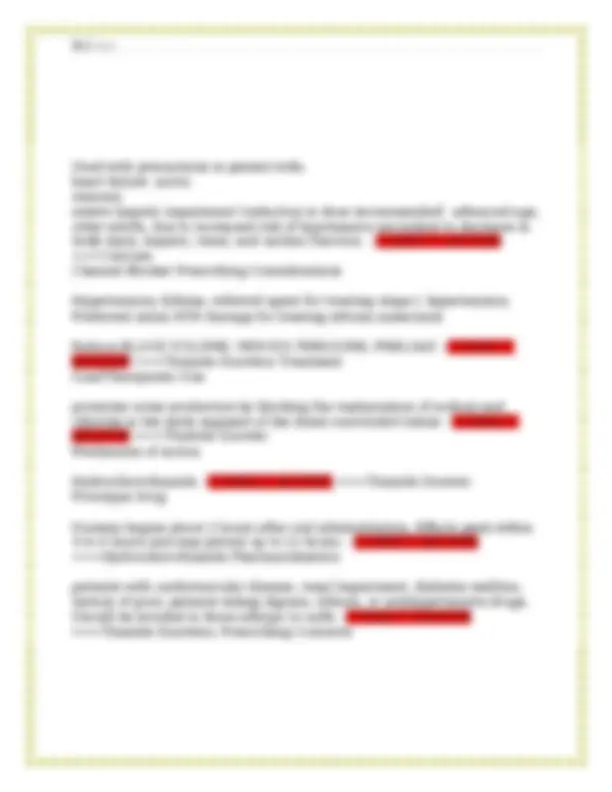

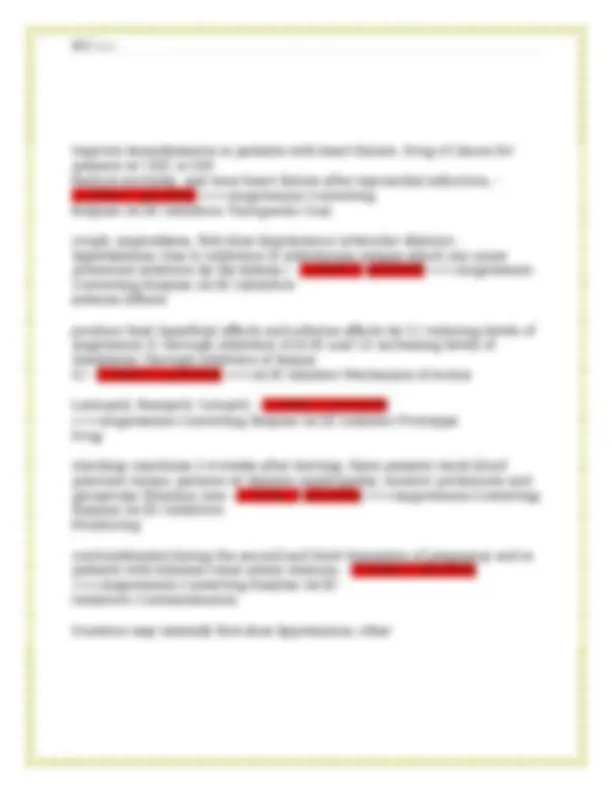
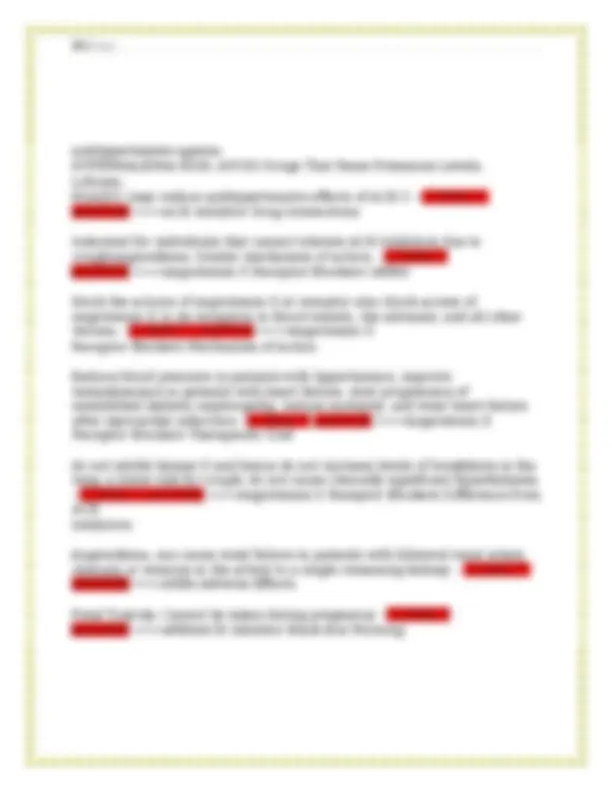
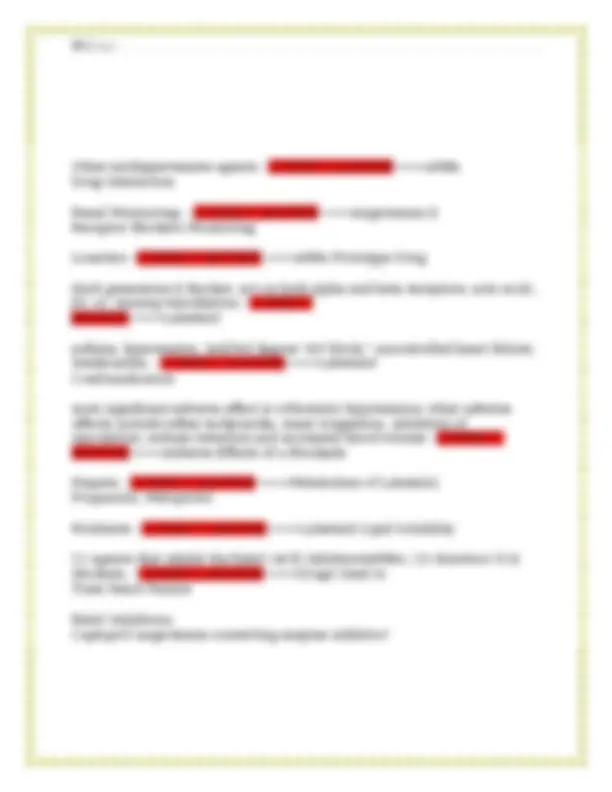
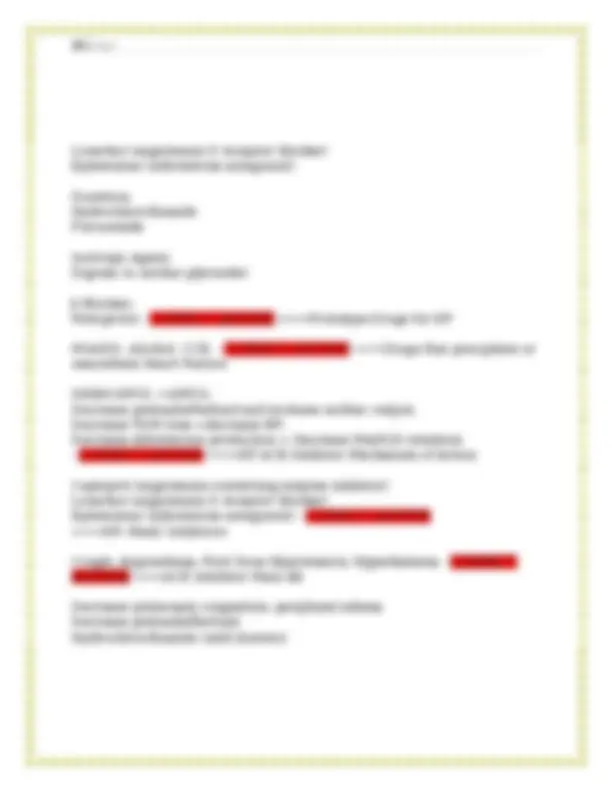
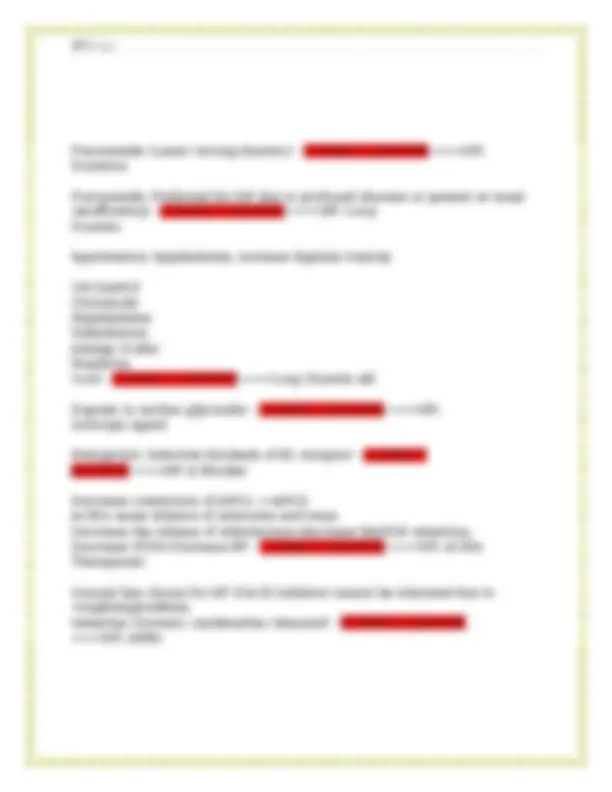
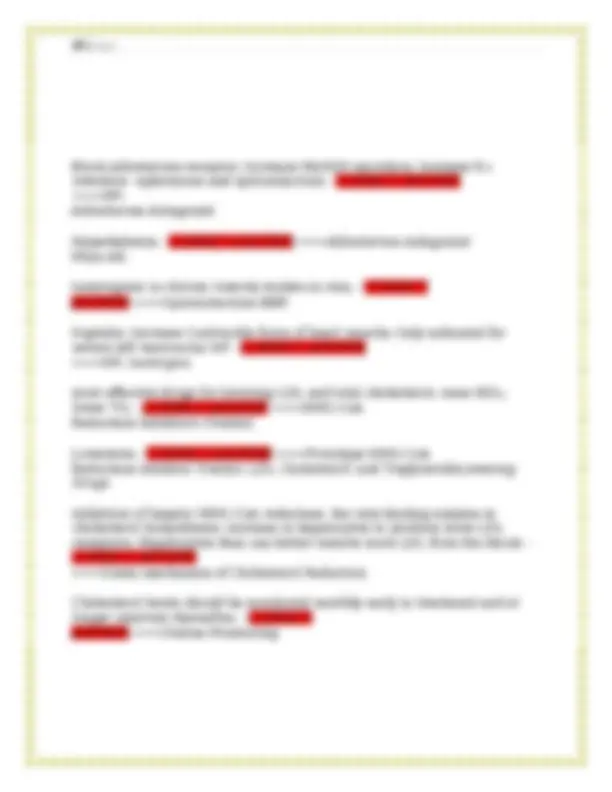
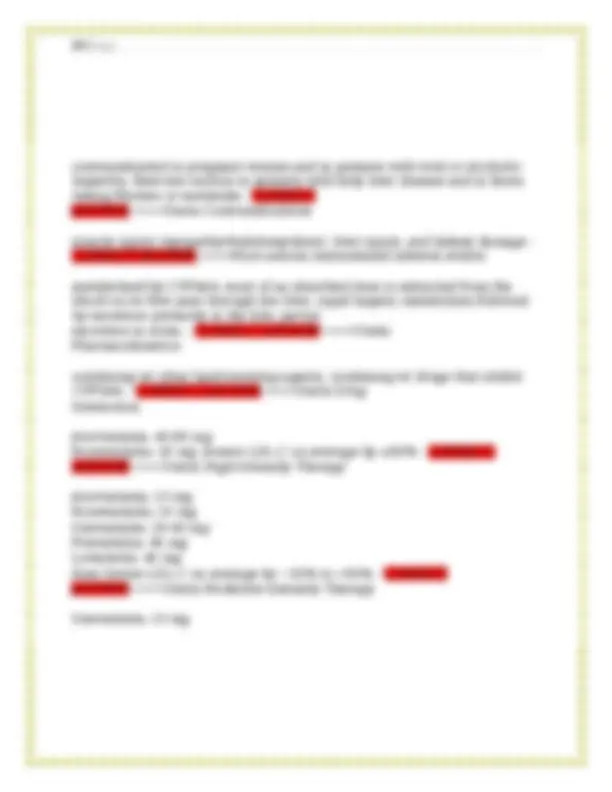
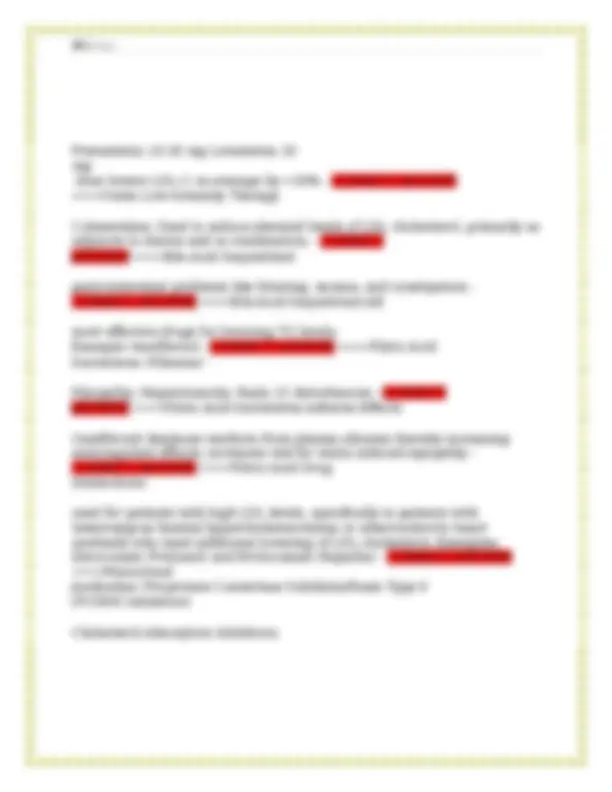
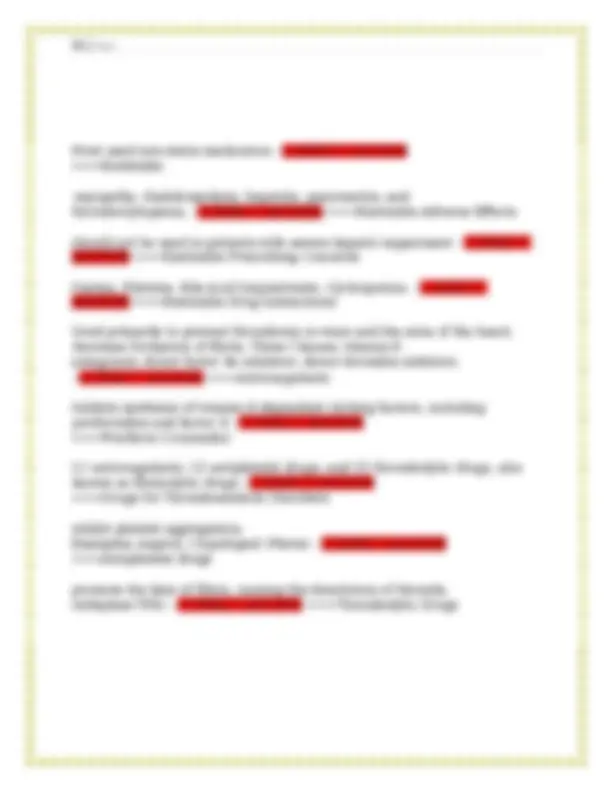
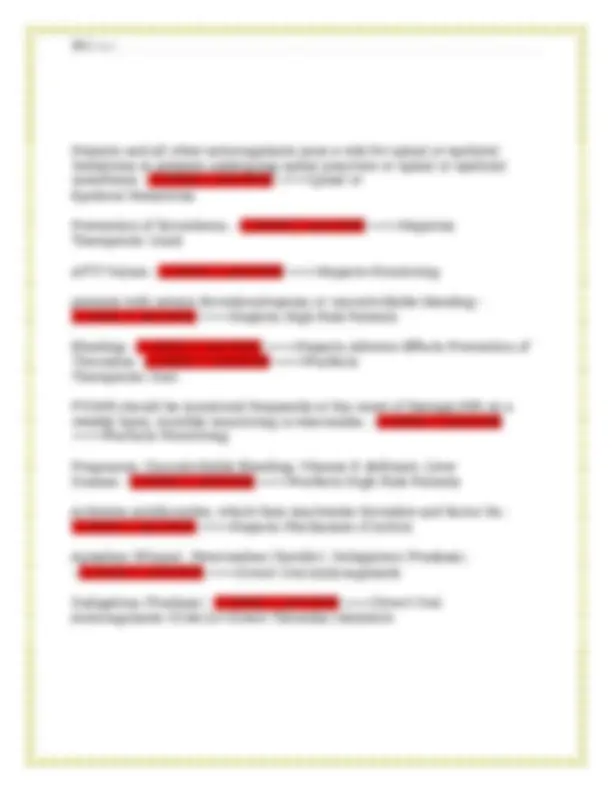
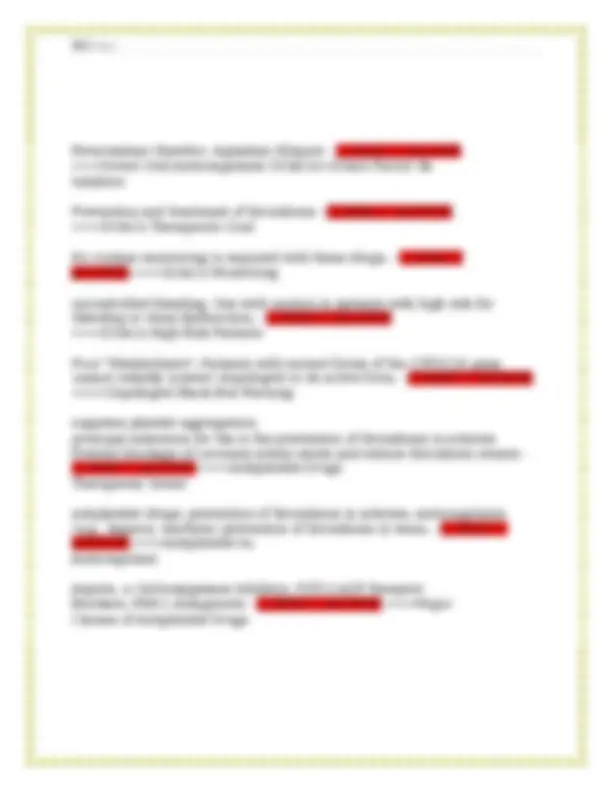
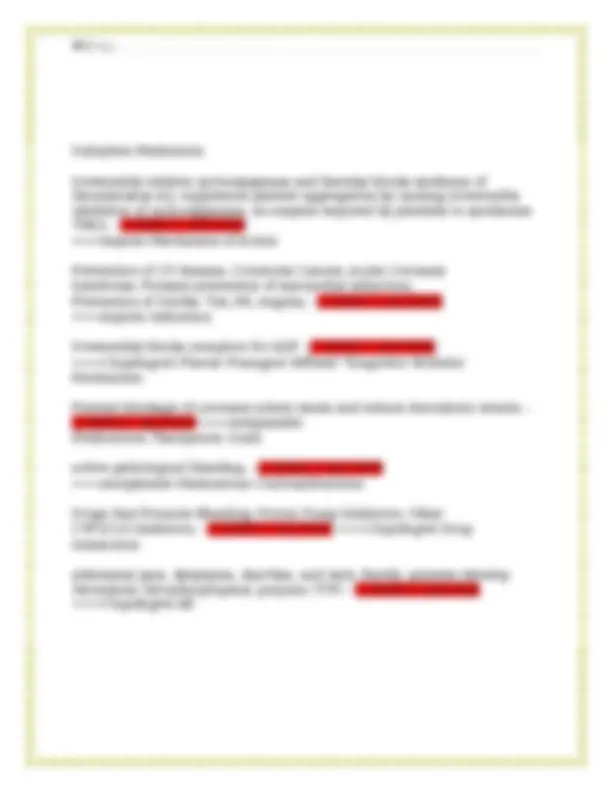
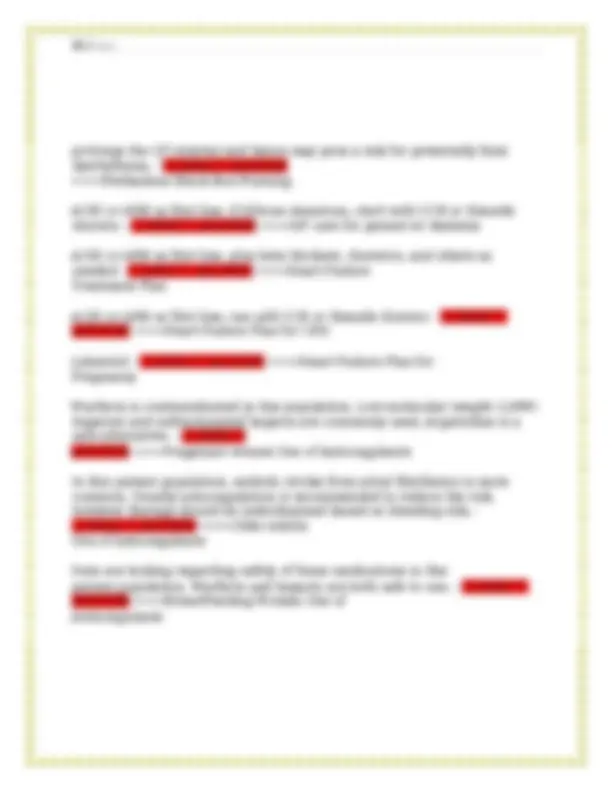
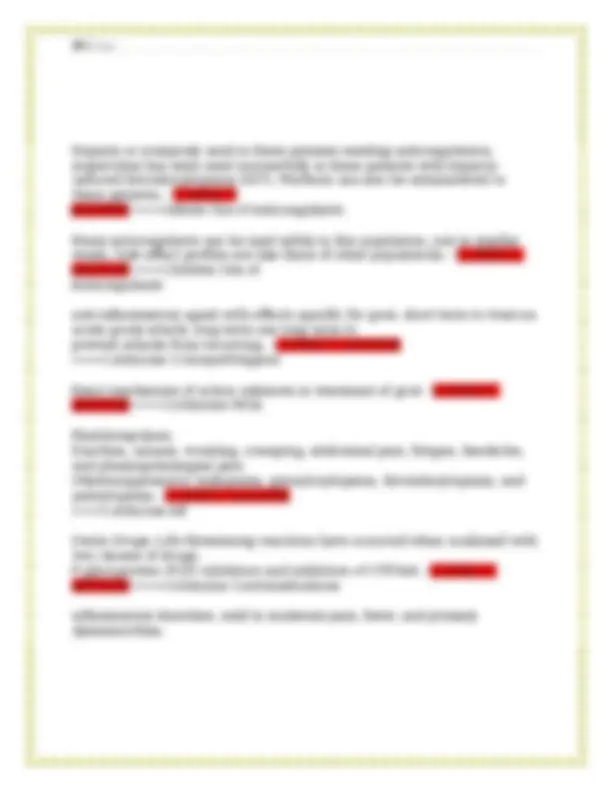

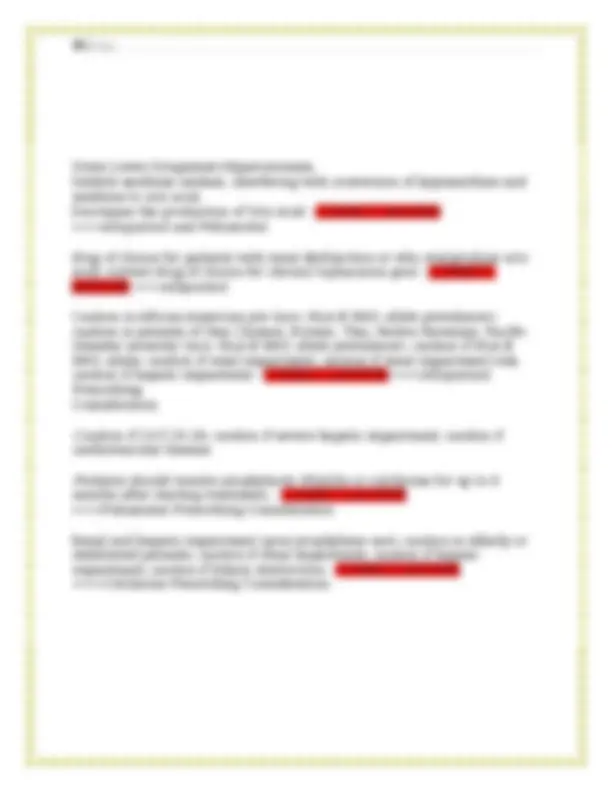
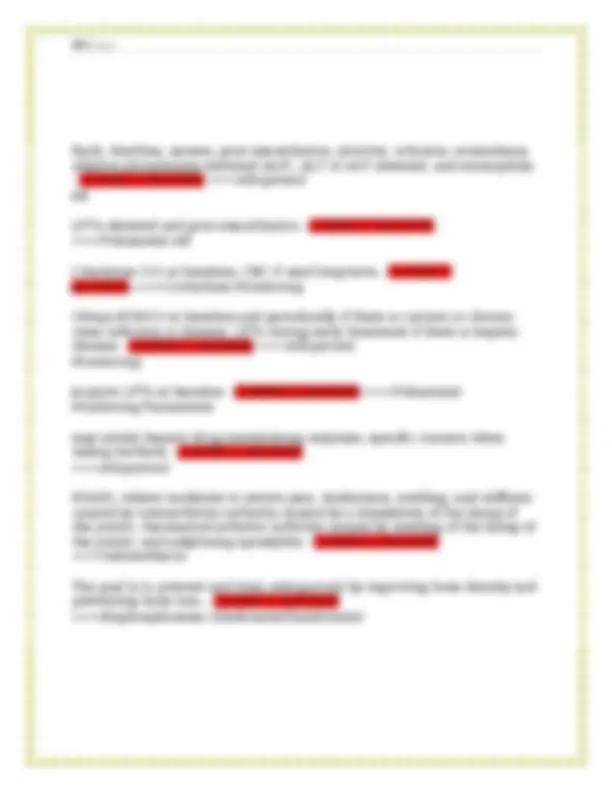
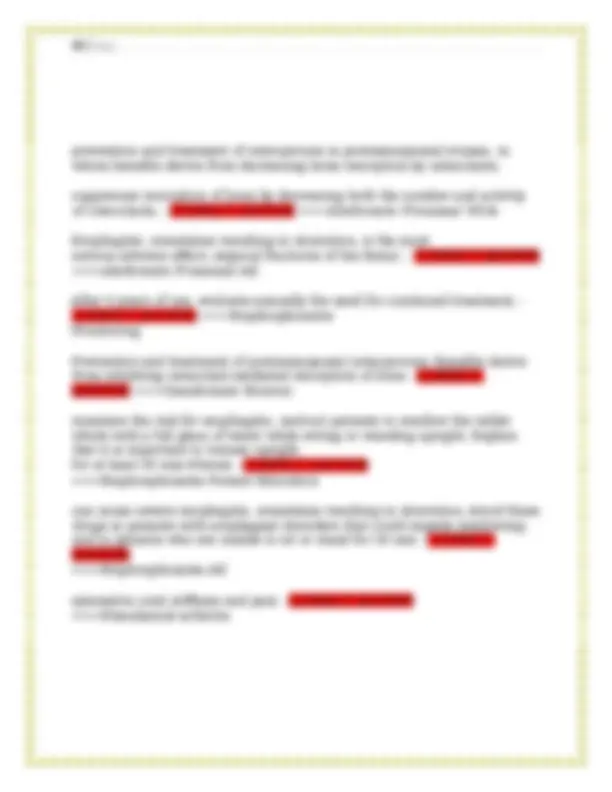

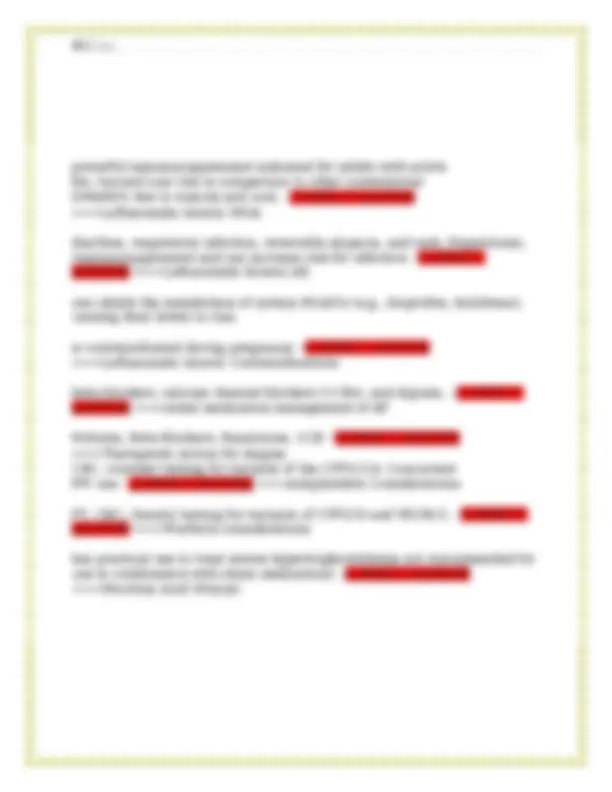


Study with the several resources on Docsity

Earn points by helping other students or get them with a premium plan


Prepare for your exams
Study with the several resources on Docsity

Earn points to download
Earn points by helping other students or get them with a premium plan
Community
Ask the community for help and clear up your study doubts
Discover the best universities in your country according to Docsity users
Free resources
Download our free guides on studying techniques, anxiety management strategies, and thesis advice from Docsity tutors
This study guide for nr 565 advanced pharmacology fundamentals at chamberlain college provides a comprehensive set of questions and answers covering key concepts in pharmacokinetics, pharmacodynamics, drug metabolism, and opioid analgesia. It includes detailed explanations of drug interactions, cyp450 inducers and inhibitors, and the beers criteria for medication use in older adults. The guide also covers opioid receptor families, types of pain, and opioid overdose treatment.
Typology: Exams
1 / 42

This page cannot be seen from the preview
Don't miss anything!



































The process by which drugs are absorbed, distributed within the body, metabolized, and excreted. - CORRECT ANSWER
Pharmacokinetics The study of what the drug does to the body - CORRECT ANSWER >>>Pharmacodynamics Rate of dissolution Surface area Blood flow Lipid solubility pH partitioning - CORRECT ANSWER >>>Factors Affecting Drug Absorption Blood flow to tissues Ability to exit the vascular system Blood-brain barrier Protein-binding capacity - CORRECT ANSWER >>>Factors Affecting Drug Distribution substances that are foreign to the body, usually synthetic chemical compounds; medications are a common example - CORRECT ANSWER Xenobiotics xenobiotic-metabolizing enzymes necessary for the production of cholesterol and steroids and the detoxification of chemicals and drug metabolism. - CORRECT ANSWER >>>Cytochrome P450 (CYP450) responsible for phase 1 metabolism in which drugs are oxidized, reduced, or hydrolyzed - CORRECT ANSWER Function of Cytochrome P450 (CYP450) Oxidation; Reduction; Hydrolysis - CORRECT ANSWER >>>Phase 1 Metabolism of Drugs via P
disease or medication-syndrome interactions that may exacerbate the disease or syndrome -medications to be used cautiously in older adults -clinically significant drug interactions that should be avoided in older adults -medications to be avoided or dosage decreased in the presence of impaired kidney function in older adults - CORRECT ANSWER >>>Beers Criteria when one medication systemically alters the potency of another medication.
Absorption Interaction caused by the amount of unbound/free medications available at the various target sites. - CORRECT ANSWER >>>Distribution Interaction concentration of the medication after biotransformation into active and inactive metabolites in higher or lower than expected. - CORRECT ANSWER >>>Metabolism Interaction the body's ability to eliminate medications in pure form or by altering a metabolite from the body. - CORRECT ANSWER Elimination Interaction does not alter or impact absorption, distribution, metabolism, or elimination because of the one medication's ability to manipulate the effect of another medication at its site of action
refers to the nurse practitioner's authority to prescribe medications. - CORRECT ANSWER >>>prescriptive authority Nurse practitioners have the autonomy to evaluate patients, diagnose, order and interpret tests, initiate and manage treatments and prescribe medications, including controlled substances without physician oversight. - CORRECT ANSWER
Full-practice scope Nurse practitioners are limited in at least one element of practice. The state requires a formal collaborative agreement with an outside health discipline for the nurse practitioner to provide patient care. - CORRECT ANSWER Reduced-practice scope Nurse practitioners are limited in at least one element of practice by requiring supervision, delegation, or team management by an outside health discipline for the nurse practitioner to provide patient care. - CORRECT ANSWER Restricted practice scope DEA Scheduled Drugs - CORRECT ANSWER >>>Drugs that cannot be ordered via E-Script Schedule II drugs - CORRECT ANSWER >>>Drugs that cannot be prescribed or refilled via phone An occurrence of fewer than three months and is often precipitated by trauma and acute medical conditions or treatment. - CORRECT ANSWER Acute Pain Referred Pain Acute Somatic Pain Acute visceral pain - CORRECT ANSWER >>>Types of Acute Pain episode of pain that lasts for 6 months or longer; may be intermittent or continuous - CORRECT ANSWER >>>Chronic pain pain that is felt in a location other than where the pain originates - CORRECT ANSWER >>>Referred Pain -Arises from connective tissue, muscle, bone and skin. -Sharp and localized or dull and non-localized
Oxycodone (Roxicodone, Oxycontin); Hydrocodone (Vicodin) - CORRECT ANSWER >>>Moderate to Strong Pure Opioid Agonists The actions of these drugs at μ and κ receptors When administered alone, produce analgesia. However, if given to a patient who is taking a pure opioid agonist, can antagonize analgesia Prototype Drug: Pentazocine - CORRECT ANSWER >>>AgonistAntagonist Opioids drug is indicated for mild to moderate pain and is much less effective than morphine against severe pain. acts as an agonist at κ receptors and as an antagonist at μ receptors. the drug produces analgesia, sedation, and respiratory depression. If administered to a patient who is physically dependent on a pure opioid agonist, can precipitate withdrawal; this is due to agonist effect at (mu) receptor which this drug antagonizes. - CORRECT ANSWER
Pentazocine (Talwin) act as antagonists at μ and κ receptors; Their principal use is reversal of respiratory and CNS depression caused by overdose with opioid agonists. methylnaltrexone—is used to treat opioid-induced constipation. Naloxone (Narcan) is the prototype of the pure opioid antagonists. - CORRECT ANSWER >>>Pure opioid antagonists Moderate to Severe Pain - CORRECT ANSWER >>>Opioid Pain Consideration Referral to a pain specialist is required for patients who take this dose of Morphine Milligram Equivalents - CORRECT ANSWER >>>120 mg per day of morphine milligram equivalents Sedation, Nausea/Vomiting, Constipation, Urinary Retention, Potential for Addiction, Respiratory Depression; Pupillary Dilation - CORRECT ANSWER >>>Adverse Effects of Opioids
classic triad of signs: coma, respiratory depression, and pinpoint pupils. Coma is profound, and the patient cannot be aroused. - CORRECT ANSWER
Opioid Toxicity/Overdose ventilatory support and giving an opioid antagonist. Naloxone (Narcan) is the traditional antagonist (opioid reversal) of choice. *Administering NARCAN can induce withdrawal effect in an individual who is chronically dependent on opioids. - CORRECT ANSWER >>>Opioid Overdose Treatment Pure Opioid Agonist, used to relieve pain but also treat opioid addiction. Use to treat opioid addicts restricted to opioid treatment programs approved by the designated state authority and certified by the federal Substance Abuse and Mental Health Services Administration. - CORRECT ANSWER >>>Methadone Opioid Reversal; Can cause QT prolongation and fatal dysrhythmias - CORRECT ANSWER >>>Naloxone (Narcan) Agonist-Antagonist Opioid; promotes analgesia similar to morphine; used for treatment of opioid addiction; prolongs QT interval and hence may pose a risk for potentially fatal dysrhythmia can be prescribed and dispensed in general medical settings, such as primary care offices. - CORRECT ANSWER Buprenorphine
Pure Opioid Agonists (methadone) Agonist-Antagonists (buprenorphine) substitute for the abused opioid and are given to patients who are not yet ready for detoxification. Opioid Antagonists (naltrexone) are used to discourage renewed opioid use after detoxification ( Also used for alcoholism) - CORRECT ANSWER
Drugs for Long-Term Management of Opioid Use Disorder used to discourage renewed opioid use after detoxification ( Also used for alcoholism) - CORRECT ANSWER >>>Naltrexone (ReVia) (1) opioids, (2) psychostimulants, (3) depressants, (4) psychedelics, (5) anabolic steroids, and (6) miscellaneous - CORRECT ANSWER Categories of Major Drugs of Abuse based upon the substance's medical use, potential for abuse, and safety or dependence liability. - CORRECT ANSWER Controlled Substances Act -The drug or other substance has a high potential for abuse. -The drug or other substance has no currently accepted medical use in treatment in the United States.
-There is a lack of accepted safety for use of the drug or other substance under medical supervision. -Examples include heroin, gamma hydroxybutyric acid (GHB), lysergic acid diethylamide (LSD), marijuana, and methaqualone.
-The drug or other substance has a high potential for abuse. -The drug or other substance has a currently accepted medical use in treatment in the United States or a currently accepted medical use with severe restrictions. -Abuse of the drug or other substance may lead to severe psychological or physical dependence. -Examples of Schedule II substances include morphine, phencyclidine (PCP), cocaine, methadone, hydrocodone, fentanyl, and methamphetamine. - CORRECT ANSWER
Controlled Substances Act Class 2 -The drug or other substance has less potential for abuse than the drugs or other substances in Schedules I and II. -The drug or other substance has a currently accepted medical use in treatment in the United States. •
Controlled Substances Act -The drug or other substance has a high potential for abuse. -The drug or other substance has no currently accepted medical use in treatment in the United States. -There is a lack of accepted safety for use of the drug or other substance under medical supervision. -Examples include heroin, gamma hydroxybutyric acid (GHB), lysergic acid diethylamide (LSD), marijuana, and methaqualone. - CORRECT ANSWER >>>Controlled Substance Act Class 1 have a high potential for abuse and no approved medical use in the United States - CORRECT ANSWER >>>Schedule I 10 | Page -The drug or other substance has a high potential for abuse. -The drug or other substance has a currently accepted medical use in treatment in the United States or a currently accepted medical use with severe restrictions. -Abuse of the drug or other substance may lead to severe psychological or physical dependence. -Examples of Schedule II substances include morphine, phencyclidine (PCP), cocaine, methadone, hydrocodone, fentanyl, and methamphetamine. - CORRECT ANSWER >>>Controlled Substances Act Class 2 -The drug or other substance has less potential for abuse than the drugs or other substances in Schedules I and II. -The drug or other substance has a currently accepted medical use in treatment in the United States. • -Abuse of the drug or other substance may lead to moderate or low physical dependence or high psychological dependence. -Anabolic steroids, codeine products with aspirin or Tylenol, and some barbiturates are examples - CORRECT ANSWER Controlled Substances Act Class 3 -The drug or other substance has a low potential for abuse relative to the drugs or other substances in Schedule III. -The drug or other substance has a currently accepted medical use in treatment in the United States. -Abuse of the drug or other substance may lead to limited physical dependence or psychological dependence relative to the drugs or other substances in Schedule III. -Examples of drugs included in Schedule IV are alprazolam, clonazepam, and diazepam. - CORRECT ANSWER >>>Controlled Substances Act Class 4 -The drug or other substance has a low potential for abuse relative to the drugs or other substances in Schedule IV. -The drug or other substance has a currently accepted medical use in treatment in the United States. 11 | Page
GABA receptor antagonist; Reversal for Benzodiazepine overdose; - CORRECT ANSWER >>>Flumazenil Reduction of the frequency and intensity of anginal attacks. Prototype Nitrate Drug; Acts directly on vascular smooth muscle (VSM) to promote vasodilation - CORRECT ANSWER >>>Nitroglycerin decreasing cardiac oxygen demand. decreases venous return to the heart and thereby decreases ventricular filling; the resultant decrease in wall tension (preload) decreases oxygen demand. - CORRECT ANSWER
Nitrates: Mechanism of Action highly lipid soluble - CORRECT ANSWER >>>Nitroglycerin: Pharmacokinetics & Pharmacodynamics headache, hypotension, and tachycardia; All secondary to vasodilation. - CORRECT ANSWER >>>Nitroglycerin: AE β blockers, CCBs, diuretics, and all other drugs that can lower blood pressure, Also, patients should be advised to avoid alcohol. phosphodiesterase type 5 inhibitors (sildenafil) is contraindicated. - CORRECT ANSWER >>>Nitroglycerin: Contraindications β blockers, verapamil, and diltiazem - CORRECT ANSWER >>>Drugs that suppress nitroglycerin-induced tachycardia No routine blood monitoring necessary - CORRECT ANSWER Nitroglycerin: Monitoring 13 | Page
keep a record of the frequency and intensity of anginal attacks and the factors that precipitate these attacks; phosphodiesterase type 5 inhibitors (sildenafil) is contraindicated. - CORRECT ANSWER >>>Nitroglycerin: Patient Teaching Indications include; hypertension, angina pectoris, heart failure, and cardiac dysrhythmias. Other uses include hyperthyroidism; migraine prophylaxis; performance anxiety, phechromocytoma; and glaucoma; Prototype drug includes: Propanolol/Metoprolol - CORRECT ANSWER >>>β Blockers Blockade of β1 receptors in the heart. 1) reduced heart rate; (2) reduced force of contraction; and (3) reduced velocity of impulse conduction through the atrioventricular (AV) node. β1 receptors in the heart. - CORRECT ANSWER >>>β-Adrenergic Antagonists Mechanism of Action Bradycardia; Reduced Cardiac Output; Precipitation of Heart Failure; AV Block; Rebound cardiac excitation; - CORRECT ANSWER >>>Adverse Effects of β1 Blockade Blockade of β2 receptors in the lungs can cause constriction of the bronchi; Hypoglycemia - CORRECT ANSWER >>>Adverse effects of β2 blockade propranolol and metoprolol. - CORRECT ANSWER >>>Prototype β Blockers first-generation β blockers, produces a nonselective β blockade; blocks both β1- and β2-adrenergic receptors - CORRECT ANSWER >>>Propranolol 14 | Page
does not interfere with β2mediated glycogenolysis. - CORRECT ANSWER
Metoprolol Adverse Effects high lipid solubility; penetrates the blood-brain barrier with ease; and (2) eliminated primarily by hepatic metabolism. - CORRECT ANSWER Metoprolol Pharmacokinetics. can mask early signs and symptoms of hypoglycemia; early signs of heart failure; abrupt discontinuation may cause tachycardia and other dysrhythmias - CORRECT ANSWER Patient Education β Blockers Principal indications are hypertension, angina pectoris, heart failure, and cardiac dysrhythmias; Monitoring for heart rate, blood pressure, other adverse effects - CORRECT ANSWER >>>Summary of Key Prescribing Considerations β-Adrenergic Antagonists sinus bradycardia AV heart block greater than first degree; great caution in patients with heart failure. Use with caution in patients with asthma, bronchospasm, diabetes, or a history of severe allergic reactions; history of depression and in patients taking calcium channel blockers. - CORRECT ANSWER >>>β blocker Contraindicated Abrupt discontinuation may cause exacerbation of angina and increases the risk for myocardial infarction. - CORRECT ANSWER Black Box Warning Metoprolol Pulmonary disease-->Bronchospasm 16 | Page
Diabetes mellitus (DM), may mask symptoms of hypoglycemia Thyrotoxicosis may mask symptoms of tachycardia and elevated blood pressure Advanced age, older adults have increased sensitivity to beta blockers, therefore, start low and go slow. - CORRECT ANSWER
Beta Blocker Special Considerations Uncompensated heart failure Pulmonary edema Bradycardia, heart block or sick sinus syndrome (in the absence of a pacemaker) - CORRECT ANSWER >>>Beta Blockers Contraindications 3rd generation; block α-adrenergic receptors in addition to β receptors; can dilate blood vessels and cause postural hypotension. - CORRECT ANSWER labetalol and carvedilol -Promotes relaxation of peripheral arterioles resulting in a decreased afterload which reduces cardiac oxygen demand. -Blocks calcium channels in the heart and vascular smooth muscle; -dihydropyridines, for which nifedipine is the prototype. -nondihydropyridines, includes the drugs: verapamil and diltiazem. - CORRECT ANSWER >>>Calcium Channel Blockers Affects the Heart and Arteriole Blood Vessels; Verapamil/Diltiazem Arteriole Dilation; Slower conduction AV/SA node; Decrease cardiac contractility - CORRECT ANSWER 17 | Page
-β-adrenergic blocking agents due to similar effects of decrease heart rate, AV conduction, and contractility - CORRECT ANSWER
Verapamil/Diltiazem Drug Contraindication Grapefruit juice can inhibit the intestinal and hepatic metabolism of many drugs and thus raise their levels. - CORRECT ANSWER Verapamil/Diltiazem Food Contraindication -blocks calcium channels in the heart and blood vessels; -lower blood pressure through arteriolar dilation; -used for angina pectoris, essential hypertension, and cardiac dysrhythmias
Verapamil/Diltiazem Pharmacokinetics CONTRINDICATED in patients with hypotension, sick sinus syndrome, and second- or third-degree atrioventricular block. - CORRECT ANSWER Verapamil and Diltiazem High Risk Patients hypertension, angina, and cardiac dysrhythmias. - CORRECT ANSWER Verapamil and Diltiazem Therapeutic Indication No routine blood monitoring required. - CORRECT ANSWER Verapamil and Diltiazem Monitoring -Dihydropyridine; -blocks calcium channels in VSM of arteriole; promotes vasodilation; 19 | Page
-produces very little blockade of calcium channels in the heart - CORRECT ANSWER >>>Nifedipine HTN; Angina; Not indicated for cardiac dysrhythmias - CORRECT ANSWER >>>Nifedipine Indication No heart specific effects; edema, flushing, headache, dizziness reflex tachycardia AE: Secondary to arteriole vasodilation - CORRECT ANSWER
Nifedipine Adverse Effects approved for essential hypertension and angina - CORRECT ANSWER Dihydropyridines/Nifedipine Therapeutic Goal hypotension, use cautiously w/ sick sinus syndrome, heart failure, and second- or third-degree atrioventricular block. - CORRECT ANSWER Dihydropyridines/Nifedipine High Risk Patients Reflex tachycardia can be suppressed with a β blocker. Peripheral edema can be reduced with a diuretic - CORRECT ANSWER >>>Dihydropyridines/Nifedipine Adverse Effects well absorbed after oral administration but undergoes extensive first-pass metabolism; only about 50% of an oral dose reaches the systemic circulation. - CORRECT ANSWER Nifedipine Pharmacokinetics systolic blood pressure < 90 mm Hg sick sinus syndrome recent myocardial infarction (MI) or pulmonary congestion second- or third- degree AV block (unless the patient has a pacemaker) concurrent use with rifampin (Rifadin®) - CORRECT ANSWER Calcium Channels Blockers Contraindications 20 | Page